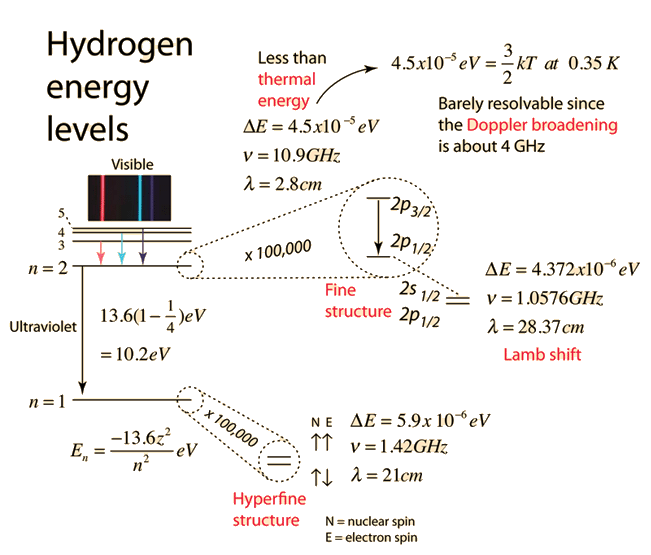The Hydrogen 21-cm Line
The hydrogen in our galaxy has been mapped by the observation of the 21-cm wavelength line of hydrogen gas. At 1420 MHz, this radiation from hydrogen penetrates the dust clouds and gives us a more complete map of the hydrogen than that of the stars themselves since their visible light won't penetrate the dust clouds.
The 1420 MHz radiation comes from the transition between the two levels of the hydrogen 1s ground state, slightly split by the interaction between the electron spin and the nuclear spin. The splitting is known as hyperfine structure. Because of the quantum properties of of radiation, hydrogen in its lower state will absorb 1420 MHz and the observation of 1420 MHz in emission implies a prior excitation to the upper state.

This splitting of the hydrogen ground state is extremely small compared to the ground state energy of -13.6 eV, only about four parts in ten million. The two states come from the fact that both the electron and nuclear spins are 1/2 for the proton, so there are two possible states, spin parallel and spin antiparallel. The state with the spins parallel is slightly higher in energy (less tightly bound).
 | In visualizing the transition as a spin-flip, it should be noted that the quantum mechanical property called "spin" is not literally a classical spinning charge sphere. It is a description of the behavior of quantum mechanical angular momentum and does not have a definitive classical analogy. |
The observation of the 21cm line of hydrogen marked the birth of spectral-line radio astronomy. It was first observed in 1951 by Harold Ewen and Edward M. Purcell at Harvard, followed soon afterward by observers in Holland and Australia. The prediction that the 21 cm line should be observable in emission was made in 1944 by Dutch astronomer H. C. van de Hulst.

Active illustration: click for more detail
Hydrogen concepts
Reference
Harwit.
| HyperPhysics***** Quantum Physics | R Nave |